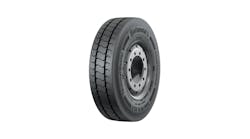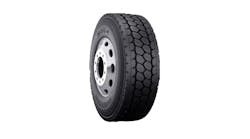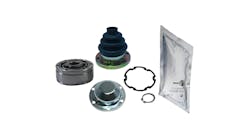Every fourth Labor Day, the United Auto Workers usually puts on a big parade in Detroit and names which automaker—Ford, General Motors, or Stellantis—will go first in the union’s quadrennial contract negotiations, with the other OEMs falling in line later. As the week gets going following Labor Day, it’s anybody’s guess how contract negotiations between the automakers and their union will go.
It’s been mixed bag for transportation and labor issues this summer.
An economy-crippling strike of 340,000 UPS Inc. drivers and package-handlers was avoided in late July when the parcel-delivery giant settled on a new contract with the International Brotherhood of Teamsters (IBT) that each side hailed as a victory.
See also: Equipment market braces for Yellow’s used tractor, trailer sales
Yellow Corp. was claiming no such victories as the less-than-truckload giant was going under last month, filing for bankruptcy Aug. 6 and blaming the IBT for hampering its third restructuring in 15 years and for the demise of the company. The union countered by blasting Yellow executives’ greed and failed financial stewardship of the carrier, whose customers fled after the Teamsters threatened—but did not carry out—a strike after Yellow said it would miss pension and health care benefits payments. About 30,000 employees, including 22,000 Teamsters members, lost their jobs at Yellow—and many are still looking for trucking industry work at other carriers.
The UAW situation is itself precarious and involves around 146,000 workers between all union members at the Big Three combined. We put together a cheat-sheet to sum up what’s happening, what may happen, and what’s at stake in the UAW standoff with the automakers.
How often does the UAW negotiate its contracts with Ford, GM, and Stellantis?
Once every four years.
What’s different about union negotiations this year?
Leadership: An embezzlement scandal involving more than a dozen UAW officials brought a federally assigned independent monitor and reforms to UAW leadership elections. One-person, one-vote paved the way for the current president, Shawn Fain, to win election in a close race.
Tone: Fain is using much more aggressive language to stir up the rank-and-file membership than previous union chiefs. Last month, Fain declined to do the traditional beginning-of-contract-negotiations ceremonial handshake with leaders of the automakers.
Lee Adler, a labor attorney and lecturer at Cornell University’s School of Industrial and Labor Relations (IRL), said Fain’s more populist tone matches his base—the workers themselves, not UAW leadership like in the past. “Mr. Fain will need to, in large part, make his credibility with the membership on the outcome of these negotiations,” Adler observed.
Momentum: Strike activity nationwide has increased overall since the pandemic. According to the IRL’s Labor Action Tracker, the first six months of 2021 saw 141 labor actions, compared to 233 for the first six months of 2023. In addition, across-the-board gains for union workers at companies such as John Deere in 2021 (UAW) and the UPS this year (Teamsters) have raised the public profile of unions.
John Deere workers went on strike for a month in October 2021 and voted down two contracts, approving a third that gave them a 20% increase in wages over six years (vs. 5% to 6% in the original contract), restored a cost-of-living adjustment that had been removed in the 2015 contract and improved retirement benefits.
In contract negotiations with the Teamsters this year that averted a strike, UPS agreed to end its two-tier employment structure that put more recent hires on a lower pay scale, and workers won a big pay bump and more full-time opportunities for part-timers.
“The deals that John Deere got, and the agreement UPS got with the Teamsters, put some weight behind the UAW’s argument: ‘We need to be responsive, so our people make more money and get back the benefits they lost,’” said Dennis Devaney, a corporate labor attorney for Clark Hill who served on the National Labor Relations Board from 1988 to 1994. “And also, to continue to allow [automakers] to transition this business into electric vehicles.”
Another clear win for the UAW occurred in August, when workers at Ultium, the new GM-LG joint venture electric-vehicle battery cell plant in Lordstown, Ohio, overwhelmingly voted to join the UAW, then gained a 25% pay raise and back pay in their contracts.
What are the UAW’s big demands of the automakers?
- Substantial raises: Fain has talked about raises of over 40% over four years, pointing out that Detroit Three CEOs had 40% pay increases on average over the last four years. By comparison, the last UAW contract in 2019 had two 3% wage hikes. Fain has floated the idea of a 32-hour week for workers, for 40 hours’ pay.
- End the two-tier wage structure: Devaney sees the UAW having leverage in this area as the Teamsters were able to eliminate tiers for their part-time workers at UPS in July.
- Restore cost-of-living adjustments: Inflation boosts to wages went away during the Great Recession.
- Restore medical benefits for retirees.
- Bring back defined pensions for workers.
What happens on Sept. 14?
The current contract with the UAW runs out. If workers do not approve a new agreement by this date, UAW leadership can declare a strike to start on Sept. 15. Historically, automakers and the union have extended existing contracts without a new one in place as long as the sides make progress in negotiations. But Fain has vowed to avoid extensions this year.
The union voted to strike, does that mean they will walk out?
No, the rank-and-file strike vote on Aug. 25 allows union leadership to authorize a strike only if the union and automakers cannot agree on a contract by Sept. 14.
What are the chances of a strike and how long would it last?
The UAW has a strike fund of $825 million. With 150,000 at $500-per-week strike pay, that fund would last 11 weeks if all workers strike at once. That fund, however, could last a year if the union is strategic about its work stoppages, Dziczek told the auto suppliers. “I think you could cripple the Detroit Three production with about 2,500 workers on strike,” she said.
Analyst Mike Bisson, in a recent Moody’s Talks Inside Economics podcast, put the likelihood of a strike at 75%, and the likelihood of a strike going more than one to two months at 45%. “Just the way both sides are talking right now, they’re not anywhere close to where they need to be,” he said.
When was the last UAW strike at the Big Three?
GM workers walked off the job in 2019. The walkout lasted 40 days. It cost GM about $3 billion, or the equivalent of 900,000 vehicles. That work stoppage also hit automotive suppliers hard.
What’s at stake for workers overall?
Keeping their union jobs as the industry slowly shifts to electric vehicles, which have fewer components and require fewer workers with different skills to produce.
More pay parity, with all workers on equal footing: Eliminating the two employment tiers for production workers that were established in 2007. Hires beginning in 2008 received considerably less pay and fewer benefits than legacy workers. In 2015 negotiations, those second-tier workers won a path to the higher scale after seven years of full-time employment, at the expense of a wage freeze for higher-paid legacy workers.
What’s at stake for the automakers?
It’s a time of uncertainty in the industry, when consumer demand doesn’t coincide with the shift to EVs—and automakers are looking for more control over decision-making, not less. Automakers are cementing new partnerships in areas like battery development and rare earth minerals and investing in new plants, equipment, and technology for the electric future. But they still must churn out gas-powered vehicles by the tens of millions to be profitable for the foreseeable future.
See also: Electrifying the final mile: What to consider
The automakers have said that meeting all UAW contract proposals—very unlikely—would increase labor costs by $80 billion over four years. Considering that the Big Three’s profits over the past decade were around $250 million, that’s quite a sum.
Adler sees the big question for the automakers—who make their biggest profits in passenger trucks—as, “What will they need for the relationship to be with the UAW to push back against Rivian and push back against Tesla, both of which are non-union?”
This article originally appeared on FleetMaintenance affiliate site IndustryWeek, an Endeavor Business Media publication.




